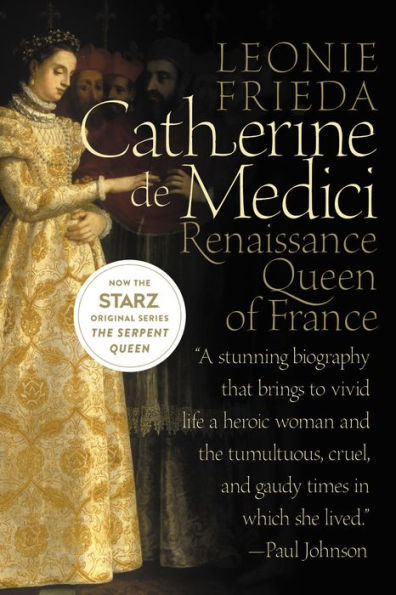Read an Excerpt
Catherine de Medici
Renaissance Queen of France
Chapter One
Orphan of Florence
She comes bearing the
calamities of the Greeks
1519-33
Caterina Maria Romula de Medici was born at around eleven o'clock on the morning of Wednesday, 13 April 1519. Her father, Lorenzo II de Medici, Duke of Urbino, scion of the ruling House of Florence, had married her mother, Madeleine de la Tour d'Auvergne, the previous year. This royal-blooded French countess and great heiress made a brilliant catch for the Medici, who were considered by many in France to be merely nouveaux riches merchants. Since their magnificent wedding, hosted by the bride's kinsman, King Francis I of France, and the couple's glorious return to Florence, there had been little cause for celebration. Madeleine's pregnancy, which had been announced in June, progressed well but the young duke, whose health had been poor for some time, had fallen ill in the autumn of 1518. Intermittent high fevers and fears over his condition led to him leaving Florence where the newlyweds had been living in princely state. The duke, probably suffering from syphilis and possibly tuberculosis, moved to the cleaner air of the surrounding countryside to await the birth of his child. By the time he returned to the city for his wife's confinement, he was dying.
Immediately after her birth, attendants carried the baby to her bedridden father for inspection. The news that her mother had by now also become very ill was kept from the duke for fear of hastening his decline. The fact that she had borne him a daughter cannot have cheered him much since there would clearly be no further issue from this illustrious couple. In an attempt to brighten the gloomy reality of the baby's sex, a contemporary chronicler applied a sycophantic gloss to the ducal disappointment: he declared that the couple 'have both been as pleased as if it had been a boy'. Due to the illness of both parents, the child's hurriedly organised baptism took place on Saturday, 16 April at the family church of San Lorenzo. With four senior clerics and two noble relations in attendance, the baby received the names Caterina, a Medici family name, Maria, since it was the day of the Holy Virgin, and Romula, after the founder of Fiesole -- although I shall henceforth refer to her throughout as Catherine. On 28 April the duchess breathed her last followed by the duke only six days later on 4 May. The entombment of the couple in the splendid family vault at the church where their baby had so recently been baptised provided a dismal conclusion to their brief marriage.
On the day the duke died his friend the poet Ariosto had arrived to condole with him over the death of the duchess. When he discovered that only an orphan child remained of the marriage that had promised a revival of the Medici fortunes he wrote a short ode: 'Verdeggia un solo ramo', dedicating it to the last hope of this pre-eminent merchant dynasty:
A single branch, buds and lo,
I am distraught with hope and fear,
Whether winter will let it blow,
Or blight it on the growing bier.
Catherine owed her existence to the obsessive Italian territorial ambitions of Francis I of France. Between the fall of the western Roman Empire and its late-nineteenth-century unification, Italy was a patchwork of principalities, duchies, and city-states. Most of these showed a precocious vigour in the arts, technology and trade, making them tempting acquisitions for outsiders. Unlike Florence, they were usually ruled by families descended from famous warriors (known as condottieri); names like the Sforza of Milan and the Gonzaga of Mantua evoke the mercenary soldiers who carved their fortunes from battle. While a small number of states such as Venice, Genoa and Florence were -- for a time at least independent, by the mid-sixteenth century the majority were ruled either directly or indirectly by Spain. From 1490 until 1559, when Spanish supremacy was established, Italy became the bloody arena where the two Continental superpowers played out their bitter struggle to dominate Europe.
Francis I, descended through his great-grandmother from the Visconti of Milan, required a sturdy ally in the peninsula to press his claim for the duchy. Accordingly, he forged an affiance with Pope Leo X, Giovanni de Medici. Unlike popes today, His Holiness was not only Christ's representative on earth, but he also exercised the temporal powers of a monarch as ruler of the Papal States, most of which were in central Italy. The papal tiara was a triple crown that placed the popes above kings and emperors; not only did the papacy hold claim to a huge amount of property throughout the Catholic world (in pre-Reformation England one fifth of the land was held by Rome) but the pope also had the right to legal jurisdiction in Catholic countries and many types of legal cases were referred to the Ecclesiastical Court. To strengthen his agreement with the Medici Pope, Francis decided to arrange the marriage of an orphaned Bourbon heiress, Madeleine de la Tour d'Auvergne, to Leo's nephew, Lorenzo de Medici. At Leo's instigation Lorenzo had recently snatched the duchy of Urbino from the della Rovere family.* For this enterprise the Pope had provided prodigious financial support with monies gained from the creation of thirty new cardinals. In private, Francis felt snobbishly sceptical about Lorenzo's ability to keep the newly acquired fief of Urbino, commenting that he was after all 'only a tradesman' ...
Catherine de Medici
Renaissance Queen of France. Copyright © by Leonie Frieda. Reprinted by permission of HarperCollins Publishers, Inc. All rights reserved. Available now wherever books are sold.



